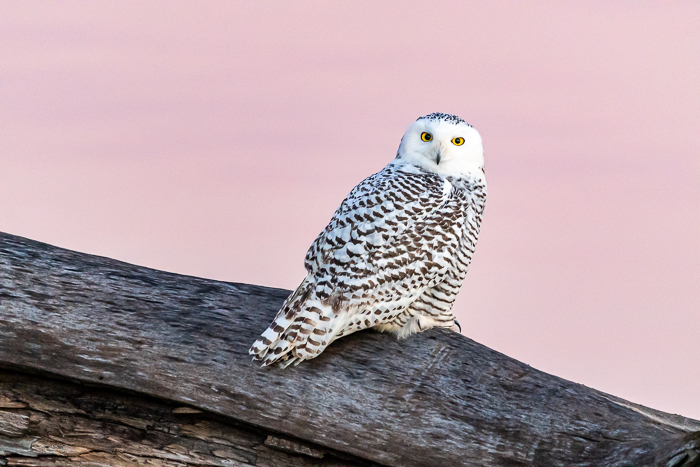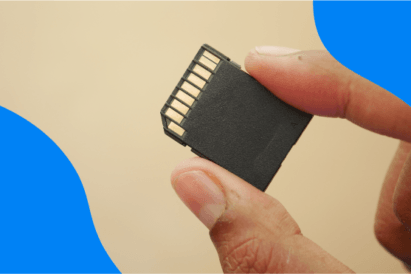A quick search online reveals a hot debate on whether photographers should buy a full-frame vs APS-C (crop) sensor digital camera. Some argue for the better image quality of full-frame sensors. Others cheer the smaller, more flexible APS-C cameras.
In this article, we will talk about the difference between full-frame vs APS-C sensors and what this means in practical terms. This will help you decide on a camera to buy.
But we will take the discussion one step further. Some full-frame cameras have an APS-C mode. Knowing the strengths of each camera sensor will help you decide when to switch sensors in your camera.

Understanding Full-Frame vs APS-C
Full-frame and APS-C refer to the size of the sensor inside of our camera. Many manufacturers sell camera bodies with different sensors.
For example, Sony markets the A7 range of full-frame cameras. The Sony a7R IV is an example. They also offer the A6000 range of APS-C cameras. The current version is the Sony a6600.
But some manufacturers, like Fuji, have gone a different direction. Fuji cameras mostly have APS-C sensors.
To understand these terms used when describing sensors, we have to go back in history to the days of film.
What is a Full-Frame Sensor?
Full-frame describes a sensor that is the same size as a film negative. This was the standard size of most 35mm cameras before digital photography. The sensor is equal to one full frame of film. In real terms, a full-frame sensor is 24x36mm.
What is a APS-C Sensor?
APS-C stands for Advanced Photo System type-C. You may guess that C stands for Crop. But it actually stands for Classic.
In the 1990s, companies like Kodak experimented with APS film. The film was about half the size of a regular negative. There were three APS formats:
- High Definition
- Classic
- Panorama
Yet this film experiment never caught on. It was probably because digital cameras soon started to appear.
But the idea of a smaller sensor size was adopted by digital camera manufacturers. Likely, the Classic format was selected because it has a similar aspect ratio (3:2) to full-frame sensors.
An APS-C sensor is 25.1×16.7mm. This is about half as large (48%) as a full-frame sensor.
Full-Frame Cameras with APS-C Modes
You can buy full-frame cameras that have an APS-C mode. The full-frame Sony A7 series cameras, like the Sony a7R III, easily toggle between full-frame and an APS-C/Super 35mm crop. In this mode, the camera uses only the central part of the sensor and acts like an APS-C sensor.
You can customise one of the action buttons to toggle APS-C on and off. This switches the camera quickly between full-frame and APS-C.
This feature adds flexibility to your photography. You can use the full-frame sensor to shoot a landscape. Then, when an interesting bird flies by, you can switch to APS-C for a closer crop.

Full-Frame vs APS-C Sensors
Now that you understand the terms camera manufacturers use to describe sensor size, let’s dive into the differences between full-frame and APS-C cameras.
Your images may look different depending on which sensor you choose. The real question is whether these differences are important to you.
Focal Length Differences
How Focal Length is Measured
The focal length of a lens is measured in millimetres (mm). This is the distance between the lens and the image sensor on a full-frame camera body.
If you attach a lens to a camera with an APS-C sensor, it results in a crop of about 1.5 (the exact factor is 1.43). That means a 50mm lens on a full-frame camera becomes a 75mm lens on an APS-C camera.
Confusingly, lens makers describe all lenses by their standard, full-frame focal lengths. This is the case even if the lens is for an APS-C camera.
This table shows the conversion of popular focal lengths to their APS-C equivalents.
Full-Frame vs. APS-C Images
Compare these two images of a snowy owl taken with my Sony A7R III. The lens with a 1.4x extender had a focal length of 560mm.
The photo on the left image used the full-frame sensor. The right image used the smaller APS-C/Super 35mm mode.
Switching to APS-C extended my field of view to 840mm. But I lost some megapixels in the switch. (We will talk about the relationship of megapixels to sensor size in another section.)


Cropped Full-Frame vs. APS-C Images
You can achieve the same result by cropping the original full-frame image. Compare the cropped full-frame image on the left with the APS-C/Super 35-mm result on the right.
The angle shifted slightly, but the owl is the same size. This zoomed-in effect is why APS-C sensors are often called ‘crop sensors’.


Crop Factor and Wide Angle Lenses
One of the advantages of an APS-C sensor is its crop factor. A by-product of the smaller APS-C sensors is that it appears to extend the length of your lens. You can get in close and fill more of the frame with your subject.
APS-C cameras are great for sports, street, and wildlife photography. But landscape and architecture photographers may find the crop factor limiting.
It is much more difficult to get a wide-angle shot with an APS-C camera. This is especially true with a super wide-angle like a 12mm lens.
For instance, the 8-16mm lens offered by Fuji results in a 12-23mm field of view. This is wide, but not super wide.
Body Size Differences
The size of the camera sensor often translates into the size of the camera. Camera manufacturers often place the smaller APS-C sensors in smaller, lighter camera bodies.
While this is not a hard-and-fast rule, it is generally the case. Also, lenses made for APS-C cameras tend to be smaller and lighter.
For example, take the Sony a6600 camera with an APS-C sensor. It is about 10% smaller and 25% lighter than the full-frame Sony a9 II.

Street and travel photographers like the smaller camera size. The cameras are smaller to pack and lighter to carry.
Also, they look less obtrusive and be less intimidating than a full-frame camera. APS-C Fuji cameras have a large following among professional street and travel photographers.
The smaller camera bodies travel well and are less noticeable. They are suitable for photographers who carry their cameras for much of the day or need good backup cameras.
But do not assume that the smaller sensor means less functionality. Sony has a history of releasing top-of-the-line features first in their APS-C bodies.
Megapixel and Image Quality Differences
The number of megapixels (MP) on a sensor is separate from sensor size. Many cameras with an APS-C sensor have around 24MP.
But sensors vary. The Fujifilm X-T4 has 26.1MP. The Canon EOS 90D has 32.5MP.
Both the smaller APS-C sensor on the Sony A6600 and the full-frame sensor of the Sony A9II have 24.2MP. When comparing these two cameras, it is not the number of pixels that matters. It is the size of each pixel.
To fit the same number of pixels on a sensor that is about 50% smaller, each pixel must also be smaller.

Advantages of Larger Full-Frame Pixels
Pixel size affects image quality. Larger pixels collect more light. This means that full-frame cameras perform better in low light situations.
The larger pixels also give full-frame sensors a wider dynamic range. All other things being equal, a full-frame camera will perform better at high ISO settings. So full-frame sensors are usually better than APS-C for astrophotography and concert photography.
Switching to APS-C/Super 35-mm mode on a full-frame camera limits how much sensor is used. But the size of the pixels does not change.
This means that the camera retains the advantages of having large pixels. But you lose access to some of the pixels. So, the size of your image is smaller. You lose pixels in the same way when you crop a full-frame image.
Comparing Megapixels in Full-Frame vs APS-C Sensor
Let’s return to the snowy owl photos taken with a full-frame and in the APS-C/Super 35-mm mode on the Sony A7RIII.
The full-frame image is 42.2MP. The photo taken with the reduced APS-C sensor has only 17.8MP. The latter is still respectable, especially for sharing photos online or small-format printing.
The Sony A7RIV is 61MP. It will create 26MP files in APS-C/Super 35-mm mode. Not only does the APS-C mode extend the reach of your lens, but the smaller files take less memory in your camera’s buffer. The latter helps when taking continuous shots or uploading images.

Depth of Field Differences
If the depth of field is important in your photography, there is one more thing to consider when deciding between a full-frame camera and an APS-C camera.
Landscape photographers often want a deep depth of field. Wildlife and portrait photographers may value a shallow depth of field.
The depth of field is different between APS-C and full-frame sensors. At the same aperture and converted focal length (e.g., 35mm on full-frame and 50mm on APS-C), the image taken with the APS-C camera will have a deeper depth of field.
This means that more of the image is in focus from the foreground to the background. Full-frame cameras will have a shallower depth of field.
This does not make one type of sensor better than the other. They simply give different results.
Macro photographers may prefer the deeper depth of field created by APS-C cameras. Portrait photographers may like the soft bokeh created by a full-frame camera.

Conclusion
Which sensor is better, full-frame or APS-C? Contrary to popular belief, full-frame sensors are not always better than APS-C sensors. Each sensor type has pros and cons.
The right sensor depends on the type of photography you do. This table shows the choices you have of full-frame vs APS-C.
Camera bodies with APS-C sensors are often marketed to hobbyist photographers as a less expensive option. But professional photographers also use crop sensor bodies.
The decision to buy a camera with a full-frame sensor or an APS-C sensor is not just about image quality. Generally, full-frame cameras will produce clearer results with less noise at higher ISOs.
But you may only see the differences when you zoom into an image. Most people rarely look at individual pixels. Photos made with an APS-C sensor can be just as powerful as ones made on a full-frame camera.
Before you go, why not filter through all the full-frame and APS-C cameras in our database to find the one that suits your needs!
















